MEMORY
by Les Solomon
Les Solomon is technical director of Computers & Electronics. He is a member of the Bug-Eyed Monster Society and practices levitation in his spare time.
When Popular Electronics ran its first cover story on the Altair in January 1975, 1 was the technical director for the magazine and therefore fortunate enough to witness and aid in the birth of the personal/ home computer. Before those early years become set in stone, I would like to offer this reminiscence and give credit to those pioneers whose names may be unknown to the home computer users now benefiting from the fruits of their labors.
It all started for me in the summer of 1972, during a vacation trip out west. My wife and I were near Albuquerque when I called Forrest Mims, a contributor to the magazine who lived in this town out in the middle of nowhere. His father had a small company called M. I. T. S. (Micro Instrumentation and Telemetry Systems), which occupied the bathroom of Forrest's mobile home and manufactured small electronic gadgets for radio-control airplanes and model rockets.

The Mims invited us out to see them, and during the
conversation Forrest mentioned that he had a friend who was as crazy
about electronics as I was. He insisted that I meet this fellow, Ed
Roberts, so later that night we got together in a steak bar in downtown
Albuquerque. Just out of the military, Ed had this idea about offering
an electronic calculator kit. And I had to listen, since he stands over
six feet and weighs 235 pounds or so.
Anyway, I decided to write about the kit in the
pages of Popular Electronics. After the article appeared, many kits
were sold and Ed bought out M.I.T.S., moved it into a real building and
dropped the periods to make it MITS. Pretty soon, everybody and his
uncle got into calculators and they were a dime a dozen. Ed was giving
serious thought to folding his company when we heard some electronic
stirrings that sounded really wild. One of our competitors,
Radio-Electronics, was preparing a story on a "computer" using an Intel
8008 microprocessor chip. Ed looked into it, obtained an even newer
Intel chip called the 8080, and with a couple of engineering friends
set about creating his own computer.
The MITS computer was ready that summer. Ed said it
could be sold as a kit for about $400, which was fantastic since I knew
the Radio-Electronics Mark-8 computer was having difficulties (no
peripherals, no language, etc. ). One day he phoned to say his first
computer was being shipped to me by Railway Express Agency. A week
later, no computer had arrived. I complained to the people at REA, who
retorted: "Our computer has never lost anything!" During the fourth
week they went bankrupt, having lost not only the first MITS computer
but their entire shipping empire as well.
Luckily, Ed had sent me another computer by a
different route. There I was, in a small office in New York with a
metal box marked PE-8 on my desk, and an ASR-33 Teletype as the only
way of inputting or displaying instructions and data. Between the
frontpanel switch start-up routine and the noisy Teletype, I was told
to take "that thing" home, which I suppose made the PE-8 the first
workable home computer.
Art Salsberg, my boss, said he would go along with
me on publishing a construction article on a microcomputer ("Heaven
only knows who will build one!"), so the next step was finding a catchy
name for our 8-bitter. After dinner one night I asked my twelveyear-old
daughter, who was watching Star Trek, what the computer on the
Enterprise was called.
"Computer," she answered.
That's a nice name, I thought, but not sexy. Then
she said:
"Why don't you call it Altair? That's where the
Enterprise is going in this episode."
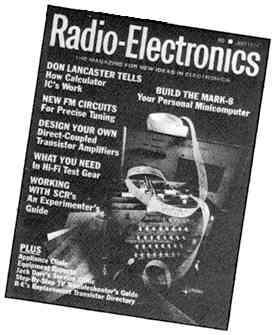 THE FIRST THE FIRSTDO-IT YOURSELF PERSONAL COMPUTER Titled simply "Computer," with the subhead "Build the Mark-8, Your Personal Minicomputer," RadioElectronic's cover story for July 1974 introduced the first homemade machine to use a microprocessor. My introduction to the Mark-8 came one bright spring morning in 1973, when a forceful young man by the name of Jonathan Titus called to tell me about his working model of a microcomputer built around the new Intel 8008. (A bargain-priced 8008 microprocessor cost $125 at the time.) Deciding that a personal visit was necessary, I flew down to Blacksburg, Virginia, where Jon took me to a spare room in his college apartment and showed me the first micro system: a little green box decorated with a bunch of toggle switches and flickering red lights. What, I wondered, would anyone do with a computer that needed to be programmed ... one step at a time ... by setting eight toggle switches to represent each instruction? Despite my misgivings and after months of preparation, we published our article on the Mark-8 computer. There was no way we could squeeze it into a single issue, and for the second time in our history we offered a booklet of complete construction information. The booklet sold by the thousands: each new stack that came in from the printer was gone in no time, and we'd have to order more. To this day I don't know how many people spent how many hours entering instructions and data into the Mark-8 ... I am often asked whether I anticipated the current personal computer revolution when I was introduced to Jon Titus' original micro system. My answer is yes, but I still don't think the computer is the ideal tool for everyone. In business and education there is no doubt that its growth as a tool and as a time- and dollar-saver will continue. When it comes to computers in the home, however, I have my doubts. I am not convinced that the average person has enough need for a computer to justify its cost. Yes, it's a great game machine. Yes, it's a great educational device. Yes, it's a great typewriter. But unless you're going to do your banking, control your home appliances, keep your holiday mailing lists, calculate your income taxes and your budget, it's difficult for me to see a personal computer in every household. Until the price of hardware comes down, and until software exists at low cost to do the kinds of things the average American needs done around the home, the computer revolution will remain largely a business revolution. LARRY STECKLER, publisher of Radio-Electronics |
The next day I called Ed to try out the new name. His answer was curt: "I don't care what you call it, if we don't sell two hundred we're doomed!" So Altair it became.
About a month before we ran the Altair story I had a visit from another imposingly large person, Roger Melen of Stanford University, who had written several articles for us. Roger contemplated the Altair set up on the table, and when I told him it was a computer his eyes glazed over. He muttered something about getting one for himself and his friend Harry Garland, who also wrote for us, and asked me for the name and address of the kit supplier. Then he vanished. Later I heard he took the next plane to Albuquerque, marched into Ed's office and bought Altair #2 right off his desk.
A few months later I got a call from Roger, asking me to fly out to San Francisco to see something very important. When I got there, he took me to the apartment he shared with Harry and showed me what he'd done with his Altair. Plugged into the machine was a double set of add-on circuit boards called the Dazzler, whose video output could create an amazing display on a color TV-the first plug-in expansion board for a personal computer. The software was called Kaleidoscope, a program that is relatively common today, but in 1976 ... ! Because of its ever-changing color display, Kaleidoscope would actually become a traffic stopper: Stan Veit ran the program all night in the window of his New York store, the first computer store east of the Mississippi, and the NYPD had to put an end to it because people kept slowing down to gawk at all those color images.
Dazzler sales went over so well that Roger and Harry formed a new company to manufacture Altair plug-ins. They decided to name it after Crothers Memorial Hall, where they had lived during their undergraduate days at Stanford. Cromemco (Crothers Memorial Company) was the first of what would become an entire subindustry of firms manufacturing add-ons to extend the capabilities of existing personal computers.
At about this time MITS held the world's first microcomputer convention, called, strangely enough, the World's First Altair Convention. Located in the Airport-Marina hotel in sunny downtown Albuquerque, it was attended by an amazing number of people who came from all over the country to see what was going on.
The Altair was a success, but the paper tape BASIC and paper tape software were an abomination. One day Jerry Ogdin, a computer consultant, had come to me with the idea of storing digital data using two tones (one for a zero, another for a zone) on an ordinary voice-grade tape cassette recorder. In September of 1975 we ran a construction article on what we called HITS (Hobbyists' Interchange Tape System), after which a number of manufacturers started using their own approach to two-tone data recording. Wayne Green, who had just started Byte magazine, wanted all the manufacturers to get together in a neutral site and hammer out a cassette standard. The site picked was Kansas City, Missouri. We all met for a weekend, and after many loud and serious discussions the Kansas City tape "standard" was born. Unfortunately, it didn't last long; before the month ended, everyone went back to his own tape standard and the recording confusion got worse.
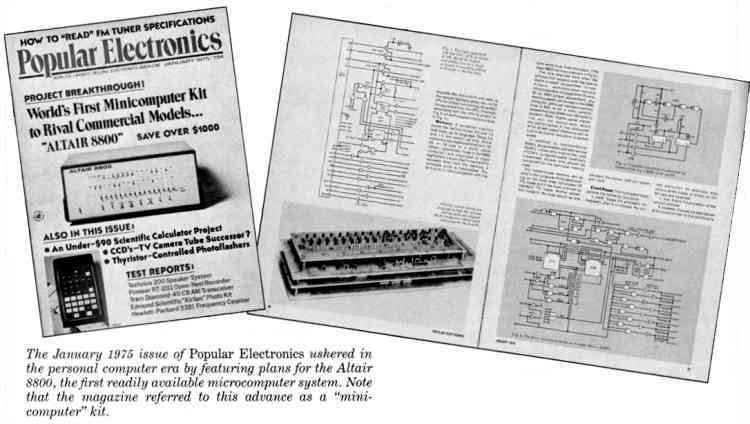 |
| THE RISE AND FALL OF THE ALTAIR Though computer kit makers like Scelbi Computer Consulting, RGS Electronics and Martin Research actually preceded MITS, the Altair 8800 with its 5100 bus and Microsoft BASIC became the foundation of the personal computer industry. More Altairs were sold than any single computer ever designed up to that time (including the famous IBM 360). Why, then, isn't MITS one of today's industry leaders? Well, perhaps because its founder, Ed Roberts, was a better engineer than businessman. When MITS struck it rich with the Altair, the small staff-less than ten people-geared up to handle the hundreds of orders that poured in. They set up manufacturing operations, software development and customer service, and even published one of the first computer magazines, Computer Notes. But problems arose because no one had ever made as many computers of one type. MITS had neither the experience nor its own capital to do the job, and in those days there were no venture capitalists breaking down doors to offer development money. Further, though computer hobbyists and potential dealers helped out with prepaid orders, Ed Roberts made some serious marketing errors. For example, MITS insisted that Altair dealers carry no other line of computers: "Ford dealers only carry Fords," Roberts declared, "and Altair dealers will only carry Altairs." When MITS could not deliver the computers, many dealers went out of business or dropped the Altair line. MITS eventually did produce the Altair 8080B, a really fine computer with a good disk system and lots of good software including business applications. The company never solved its cash flow problems, however, and eventually Ed Roberts sold out to the Pertec Computer Co., which supplied the Altair disk drives. Ed retired from the computer industry to raise pigs in Georgia, then later decided to go to medical school. Pertec, which had ambitions to become a major computer company, felt the name Altair was too identified with "hobby computers." The line was discontinued, and the Altair vanished from the market. When Pertec was itself bought out by Adler of Germany, the Altair name was condemned to oblivion. All that was left was Microsoft BASIC and the memory of the machine that started an industry. STAN VEIT |
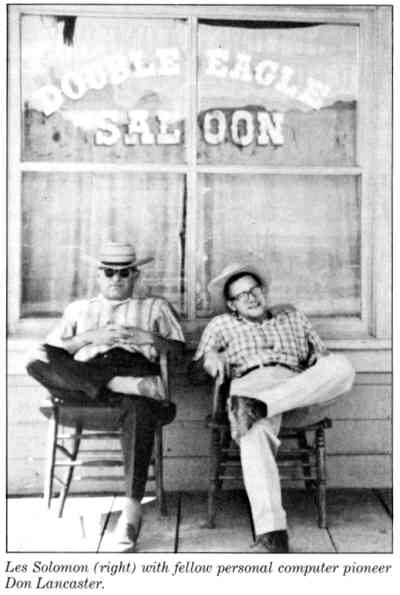
It was at Kansas City that I first met Bob Marsh,
who had formed a garage-based company in San Francisco called Processor
Technology. Along with circuit designer Lee Felsenstein, he was making
Altair memory boards and a graphics display board called the VDM-1,
also for the Altair. Lee had worked for Marty Spergel, the driving
force behind M&R Enterprises, and came through with plans for the
Pennywhistle modem-the first hobby modem, published in our March 1976
issue. Now we computer hobbyists had a low-cost way to communicate over
the telephone lines. Lee went on to design several trend-setting
computers, including the portable Osborne.
I was still unhappy. The Altair needed a video
display terminal with a self-contained keyboard. Like everyone else, I
had been constantly startled by Don Lancaster's brilliant innovations
over the years, and I knew he had just finished his TV typewriter. I
went to Phoenix, loaded Don and his typewriter into the car, and took
off for Albuquerque and MITS. One thing I must say for Don Lancaster
and Ed Roberts: they both have very strong personalities. When I got
them together in Ed's office, the clash was pretty fierce. Since the
Altair and the TV typewriter were not compatible, something had to
give. Neither man, however, would give an inch.
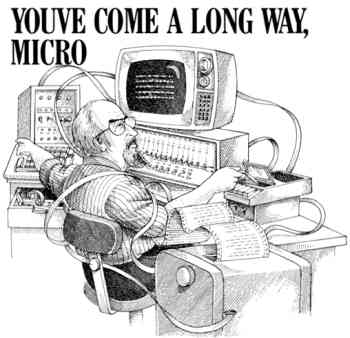 The horse-and-buggy days of home computing were not all that long ago. In fact, less than a decade has passed since I first read about the Altair and began thirsting-nay, lusting-for a computer of my own. When I finally got one, of course, there was precious little I could do with it. My Altair turned out to be just a box with toggle switches and neat rows of red LEDs (light-emitting diodes) decorating the front panel. The switches were its only input device; the LEDs were its output, glowing and darkening in patterns that showed what you had input from the switches and what the computer had done as a result. Both operated at the same simple-minded level as the computer itself, in binary numbers built up of 1s and 0s. A "1" was entered by raising a switch, a "0" by lowering it. The corresponding LEDs glowed for each "1" and darkened for each "0." A one-byte program instruction, nothing more arduous than STOP, took eight switch settings. The Plug-In Problem Luckily, there was a world beyond the binary level. I went out and got a "terminal," with keyboard and video display screen, but then found nothing on the Altair to plug it into. What I needed was an I/O (input/ output) circuit board through which the computer and terminal could communicate. The Altair had about a dozen slots where you could plug in I/O and other boards. Put a 25-pin connector into one of the oval holes in the computer's back, run a cable from the I/O board, and you had a place to plug in the terminal. Problem: typing on the terminal had no effect on what the Altair did. Just as nice children don't speak until they're spoken to, computers don't communicate with terminals until a program has told them they can and how to do it. There was such a program in octal (base-8) numbering that you could translate into binary and toggle in from the front panel of the Altair. Unfortunately, the program was several hundred bytes long; at eight bits per byte, this meant well over a thousand switch-flicks before the program was in the machine. Since a computer's random access memory becomes amnesiac the instant its power is shut off, you'd have to toggle in that program every time you wanted to use the machine. And if you made just one of those thousand switch-flicks wrong, the program wouldn't run-or would run amok, randomly changing the bits you'd toggled in correctly. The solution was to put that program, and any others you needed regularly, into an EPROM (erasable, programmable, read only memory), which would hold its contents even when the computer was shut off. A whole set of such programs fit easily into just two EPROM chips. Naturally the Altair had no place to plug in those chips, so I had to buy a Cromemco Bytesaver board to hold them and plug it into the Altair's bus. With those programs, typing in instructions like C2 D5 01 ("If the zero flag is not set, jump to the program steps at memory location 01D5") was simpler than setting switch sequences of 11000010 1101010 00000001. Writing programs in tiny steps of arbitrary symbols, however, was still infuriatingly slow. What I needed was a "high-level" programming language. By that time the Altair could run an abbreviated BASIC, the first product of a tiny new firm called Microsoft. It was only available on punched paper tape, which required a special paper-tape reader, but for once I didn't have to buy any new equipment. I had a friend with a teletype-a printing terminal that could also read and punch such tapes. I ordered BASIC and my friend read it into his machine, then rerecorded it onto a tape cassette. I might not have a paper-tape reader, but I did have a cassette recorder. Still Plugging Away Not surprisingly, the Altair had no place to plug in the cassette. Now what I lacked was a board that would translate between computer and cassette deck. With this I would have a fully functioning system, including all the major parts a computer needs: a keyboard and screen (on the terminal), mass storage (the cassette), a processor, and both ROM (built-in program) and RAM (user-programmable) memory. But the Altair came with 4K of RAM memory and the BASIC interpreter took up 8K, not counting the program you then wanted to run. The solution here was to plug in still more memory boards. In those early days, few programs were readymade, in part because not all the programs marketed for the Altair were available in the same tape format. Besides, there simply weren't that many to choose from. Then along came the next generation of personal computers: machines like the Radio Shack TRS-80 Model I, the Commodore PET and the Apple II, with resident programs in permanent memory, cassette connections, keyboards and (save for the Apple) screens built in. Not only that, but they had BASIC built in, so you could run your language immediately-no waiting while you loaded it from a tape. In principle, they were little different from my old Altair. The major difference was that these computers didn't require months of learning and searching for parts before you could use them. All you had to do was plug them in ... IVAN BERGER, technical editor of Audio magazine |
My next step was to talk to Bob Marsh of Processor Technology. It took a little doing, but I finally convinced him that a combination of his memory boards, his VDM-1 as the video display, plus an 8080, a power supply and the S-100 bus, would make a dandy "smart" terminal-or even a computer. We decided on the smart terminal approach, since I was fairly certain the magazine would not "buy" another computer. Lee Felsenstein did the preliminary design and, using one of Don Lancaster's approaches, came up with a computer. Steve Dompier and Gary Ingram did the software. Another software person, Gordon French, came up with the idea of wooden sides for the case-an odd first for computers.
In the summer of 1976 a new, easier-to-use computer was born, one with a self-contained operating system (no complex switches to get it started), built-in video capability, an integral keyboard and a small, typewriter-size enclosure. It was decided that this new approach would be called Sol. The story I was told by Marsh and Felsenstein was that if the strangelooking computer didn't fly, they had to have someone to blame it on ... guess who? At least they didn't call it the Les. Sol appeared in the July 1976 issue of Popular Electronics.
That summer there was also the famous Atlantic City Computer Conference at the snazzy Shelbourne Hotel/Motel. This was just about the first time almost all the microcomputer people got together in one place. It was a great show and the forerunner of the many computer fairs to follow.
During the 1977 First West Coast Computer Faire, I dropped in on the Heuristics Company to see what Horace Enea had wrought. His Speechlab plugin board would allow the user to actually talk to the computer, and the computer could "understand"! Not too much later Software Technology, an offshoot of Processor Technology, came up with a variation of Steve Dompier's music system (Dompier was the first to realize that microcomputers could make music) and produced a most marvelous sound system that was used in conjunction with an external audio amplifier. From now on, no microcomputer show would be silent!
The 1977 First West Coast Computer Faire (Jim Warren, chairperson) was a success in many ways. It was one of the first times such a wide variety of computer people got together in one place on the West Coast. Outside the Brooks Hall site of the show was parked a small van containing Mike Wise and his unique computer from the Sphere Company located in Bountiful, Utah. The one thing we remember about the Sphere was that its BASIC was s-1-o-w. Real s-1-o-w! The Sphere computer was never seen again: it was advertised and a couple were even delivered to computer stores, but very soon Sphere vanished from the face of the earth-a fate shared by many other pioneering computer models.
There were a lot of other developments over the years, some good, some transitory, none of them boring. Companies came and went, as did software. (Does anyone remember Target, the first personal computer game? Or Star Trek, with its umpteen versions?) Magazines also came and went. (Anyone remember ROM, with its column "From the Fountainhead" by a young writer named Adam Osborne?) Processor Technology vanished along with the late, great Sol and the unlamented Helios disk drive; Steve Jobs and Steve Wozniak came up with Apple I, a computer on a single circuit board that would lead to bigger things; Bob Suding of the Digital Group out in Denver came up with some good hardware, unfortunately too far ahead of its time.
A couple of guys in New Jersey, Roger Amidon and Chris Rutkowski, came up with a "supercomputer": the General, with its superb software. Although the General also soon folded its tent, the idea of this machine recently returned when Roger and Chris, using the Rising Star marketing firm as a base, introduced the Epson QX-10 with Valdocs word processing software-the most user-friendly computer system I've seen as of this writing and, incidentally, the machine I used to compose this account.
This just about brings me to the end of my musings about "the good old days"-to the end of 1977, just two years after the Altair. I personally don't believe we shall ever again see such an outburst of raw talent. They were great times. (If I missed any important event or name, forgive me, fellows, I am getting old.) I salute that long-haired, blue-jeans-and-T-shirt bunch, bearded or not shaven at all, fueled by hamburgers and Anchor Steam beer (I didn't forget, Steve), limited only by their imagination. They left the legacy that a handful of guys with an idea can change the world ... because that's exactly what they did. Just look around.
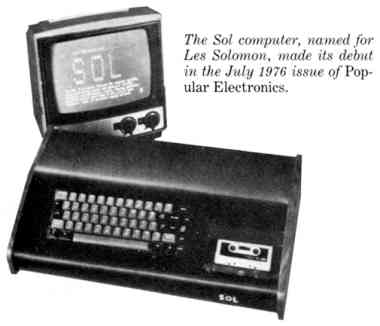
Return to Table of Contents | Previous Article | Next Article

